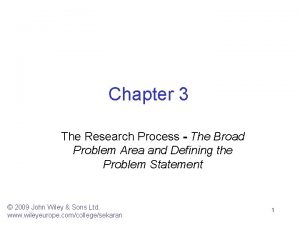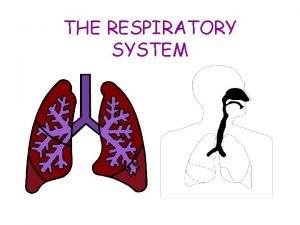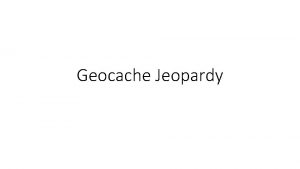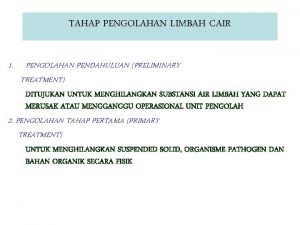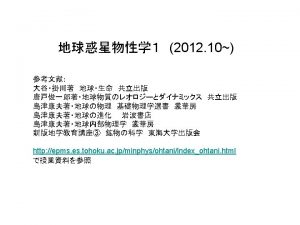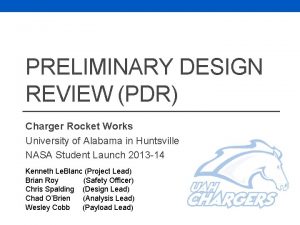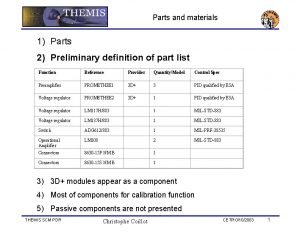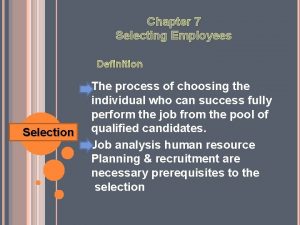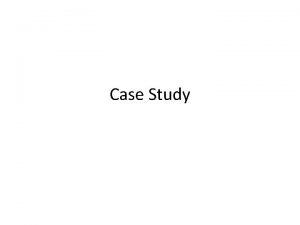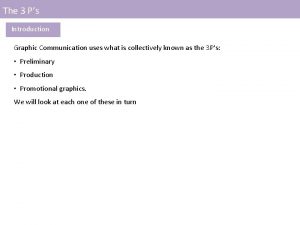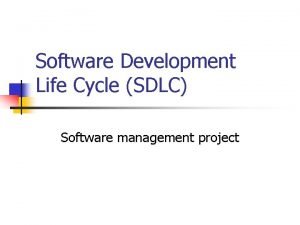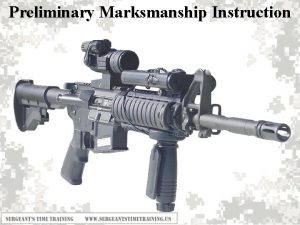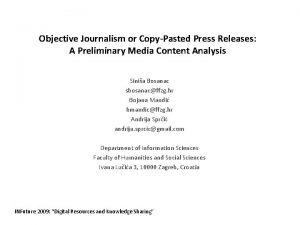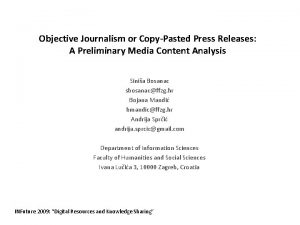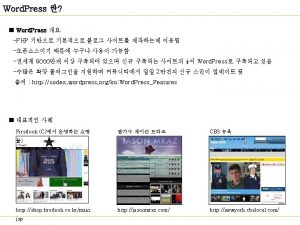Releasing Financial Information Mc GrawHillIrwin Preliminary Press Releases






























- Slides: 30

Releasing Financial Information Mc. Graw-Hill/Irwin Preliminary Press Releases Quarterly and Annual Reports Securities and Exchange Commission (SEC) Filings Investor Information Websites Slide 1

Horizontal (Trend) Analysis Horizontal analysis compares a company’s financial condition and performance over time. A year-over-year percentage change expresses the current year’s dollar change as a percentage of the prior year’s total using this formula. Percent Change Mc. Graw-Hill/Irwin = Current Year’s Total Prior Year’s Total × 100% Prior Year’s Total Slide 2

Horizontal Analysis of Lowe’s Summarized Balance Sheets Mc. Graw-Hill/Irwin Slide 3

Horizontal Analysis of Lowe’s Summarized Balance Sheets Mc. Graw-Hill/Irwin Slide 4

Horizontal Analysis of Lowe’s Summarized Income Statements Mc. Graw-Hill/Irwin Slide 5

Changes Revealed in Trend Analysis Lowe’s grew significantly in 2006. Total assets rose by 12. 7 percent Net sales revenues rose by 8. 5 percent. Gross profit rose by 9. 5 percent Net income rose by 12. 3 percent. The growth in net sales revenues more than offset the growth in expenses resulting in net income growth in 2006 that was greater than the net sales revenues growth. Mc. Graw-Hill/Irwin Slide 6

Vertical (Common Size) Analysis Vertical analysis focuses on important relationships within financial statements by expressing each financial statement amount as a percentage of another amount on that statement. Common-size percentages for financial statements are calculated using this formula. Common-size Percent = Analysis Amount Base Amount × 100% The base amount is total assets for the balance sheet and sales revenue for the income statement. Mc. Graw-Hill/Irwin Slide 7

Vertical Analysis of Lowe’s Summarized Balance Sheets Mc. Graw-Hill/Irwin Slide 8

Vertical Analysis of Lowe’s Summarized Income Statements Mc. Graw-Hill/Irwin Slide 9

Interpreting Common Size Statements Lowe’s total assets grew in 2006 by more than $3, 000, 000. Most of the growth was in property and equipment which increased from 66. 4 percent of total assets in 2005 to 68. 3 of total assets in 2006. The growth in total assets was accompanied by increases in all major categories of liabilities and equities. However, only long-term liabilities increased as a percent of total assets, from 18. 3 percent of total assets in 2005 to 19. 8 percent of total assets in 2006. Mc. Graw-Hill/Irwin Slide 10

Interpreting Common Size Statements Lowe’s was able to increase its net income as a percent of sales from 6. 4 percent to 6. 6 percent by reducing cost of goods sold as a percent of sales by 0. 3 percent. The percentage decrease in cost of goods sold was partially offset by small increase in operating and other expenses. Mc. Graw-Hill/Irwin Slide 11

Financial Ratios Financial ratio analysis compares amounts for one or more financial statement items to amounts for other financial statement items in the same year. Mc. Graw-Hill/Irwin Slide 12

Profitability Ratios Profitability ratios provide us with measures of a company’s ability to generate income in the current period. Net profit margin Gross profit percentage Asset turnover Return on equity (ROE) Mc. Graw-Hill/Irwin Fixed asset turnover Earnings per share (EPS) Price/earnings (P/E) Return on assets (ROA) Slide 13

Profitability Ratios Net Profit Margin Net profit margin = Net income Net sales revenue × 100% Lowe’s 2006: ($3, 105 ÷ $46, 927) × 100% = 6. 6% Lowe’s 2005: ($2, 765 ÷ $43, 243) × 100% = 6. 4% Net profit margin represents the percentage of sales revenue that remains in net income after expenses have been deducted. Mc. Graw-Hill/Irwin Slide 14

Profitability Ratios Gross Profit Percentage Gross profit = percentage Net sales ‒ Cost of goods sold Net sales × 100% Lowe’s 2006: (($46, 927 ‒ $30, 729) ÷ $46, 927) × 100% = 34. 5% Lowe’s 2005: (($43, 243 ‒ $28, 453) ÷ $43, 243) × 100% = 34. 2% Gross profit percentage indicates how much profit was made, on average, on each dollar of sales, after deduction of cost of goods sold. Mc. Graw-Hill/Irwin Slide 15

Profitability Ratios Asset Turnover Asset turnover = Net sales revenue Average total assets Lowe’s 2006: $46, 927 ÷ (($27, 767 + $24, 639) ÷ 2) = 1. 79 Lowe’s 2005: (Given) = 1. 89 The asset turnover ratio indicates the amount of sales revenue generated for each dollar invested in assets. Mc. Graw-Hill/Irwin Slide 16

Profitability Ratios Fixed Asset Turnover Fixed asset turnover = Net sales revenue Average net fixed assets Lowe’s 2006: $46, 927 ÷ (($18, 971 + $16, 354) ÷ 2) = 2. 66 Lowe’s 2005: (Given) = 2. 86 The fixed asset turnover ratio indicates the amount of sales revenue generated for each dollar invested in fixed assets such as store buildings and land used in the business. Mc. Graw-Hill/Irwin Slide 17

Profitability Ratios Return on Assets (ROA) Net income ROA = Average total assets × 100% Lowe’s 2006: $3, 105 ÷ ($27, 767 + $24, 639) ÷ 2) × 100% = 11. 8% Lowe’s 2005: (Given) = 12. 1% The return on assets ratio measures how much a company earns for each dollar of investment in assets. Mc. Graw-Hill/Irwin Slide 18

Profitability Ratios Return on Equity (ROE) ROE = Net income Average stockholders’ equity × 100% Lowe’s 2006: $3, 105 ÷ (($15, 725 + $14, 296) ÷ 2) × 100% = 20. 7% Lowe’s 2005: (Given) = 21. 4% The return on equity ratio measures the amount earned as a percentage of each dollar invested by stockholders. Mc. Graw-Hill/Irwin Slide 19

Profitability Ratios Earnings per Share (EPS) Net income EPS = Average number of common shares EPS is reported in the income statement. Lowe’s 2006: EPS = $2. 02 Lowe’s 2005: EPS = $1. 78 Earnings per share indicates the amount of earnings for each share of outstanding common stock. Mc. Graw-Hill/Irwin Slide 20

Profitability Ratios Price/Earnings (P/E) Ratio P/E Ratio = Stock price EPS The stock price was $31 per share at the time 2006 earnings were announced. Lowe’s 2006: $31 ÷ $2. 02 = 15. 3 Lowe’s 2005: (Given) = 16. 3 The P/E ratio measures the relationship between the current market price of the stock and its earnings per share. Mc. Graw-Hill/Irwin Slide 21

Liquidity Ratios Liquidity ratios focus on a company’s ability to convert its assets into cash in order to pay current liabilities as they come due. Receivables turnover Inventory turnover Current ratio Quick ratio Mc. Graw-Hill/Irwin Slide 22

Liquidity Ratios Receivables Turnover Receivables turnover = Net sales revenue Average net receivables Lowe’s receivables balance from customers is insignificant because most sales are cash or credit card sales. The receivables turnover ratio is a measure of how fast a company collects its receivables. Mc. Graw-Hill/Irwin Slide 23

Liquidity Ratios Inventory Turnover Inventory turnover = Cost of sales Average inventory Lowe’s 2006: $30, 729 ÷ (($7, 144 + $6, 635) ÷ 2) = 4. 5 Lowe’s 2005: (Given) = 4. 5 The inventory turnover ratio indicates how many times inventory is bought and sold during the period. Mc. Graw-Hill/Irwin Slide 24

Liquidity Ratios Days to Sell Days to sell = 365 Inventory turnover ratio Lowe’s 2006: 365 ÷ 4. 5 = 81. 1 days Lowe’s 2005: 365 ÷ 4. 5 = 81. 1 days The days to sell ratio converts inventory turnover into the number of days need to sell inventory. Mc. Graw-Hill/Irwin Slide 25

Liquidity Ratios Current Ratio Current ratio = Current assets Current liabilities Lowe’s 2006: $8, 314 ÷ $6, 539 = 1. 27 Lowe’s 2005: $7, 788 ÷ $5, 832 = 1. 34 The current ratio measures the ability of a company to pay its current debts as they become due. Mc. Graw-Hill/Irwin Slide 26

Liquidity Ratios Quick Ratio Quick ratio = Quick assets Current liabilities Lowe’s 2006: $796 ÷ $6, 539 = 0. 12 Lowe’s 2005: $876 ÷ $5, 832 = 0. 15 The quick ratio is similar to the current ratio, but measures the company’s immediate ability to pay it current debts. Mc. Graw-Hill/Irwin Slide 27

Solvency Ratios Solvency ratios focus on a company’s ability to repay debt, pay interest, and finance replacement and/or expansion of long-term assets. Times interest earned Debt-toassets Mc. Graw-Hill/Irwin Free cash flow Slide 28

Solvency Ratios Debt-to-assets Ratio Debt-to assets = Total liabilities Total assets Lowe’s 2006: $12, 042 ÷ $27, 767 = 0. 43 Lowe’s 2005: $10, 343 ÷ $24, 639 = 0. 42 The debt-to-assets ratio indicates the proportion of total assets that is financed by creditors. Mc. Graw-Hill/Irwin Slide 29

Solvency Ratios Times Interest Earned Ratio Times interest earned = Net Interest Income tax + + income expense Interest expense Lowe’s 2006: ($3, 105 + $154 + $1, 893) ÷ $154 = 33. 5 Lowe’s 2005: ($2, 765 + $158 + $1, 731) ÷ $158 = 29. 5 The times interest earned ratio indicates the number of times a company’s interest expense was covered by its operating results. Mc. Graw-Hill/Irwin Slide 30
 Broad problem area
Broad problem area Single flat wrap
Single flat wrap Hypothalamus hormones
Hypothalamus hormones Combination clasp design
Combination clasp design Energy-releasing pathways
Energy-releasing pathways Respiratory system jobs
Respiratory system jobs Corticotropin releasing hormone
Corticotropin releasing hormone Maxine greene releasing the imagination
Maxine greene releasing the imagination Terminal rest rpd
Terminal rest rpd Where is thyrotropin-releasing hormone (trh) made?
Where is thyrotropin-releasing hormone (trh) made? Fixed pattern action
Fixed pattern action Cellular respiration releases
Cellular respiration releases Cellular respiration releases
Cellular respiration releases Cisco network insights
Cisco network insights Which structure releases glucagon
Which structure releases glucagon The yucca plant releases a strong scent at night
The yucca plant releases a strong scent at night The yucca plant releases a strong scent at night
The yucca plant releases a strong scent at night Preliminary budget
Preliminary budget Preliminary treatment adalah
Preliminary treatment adalah Preliminary survey audit
Preliminary survey audit P 波
P 波 Preliminary design review example
Preliminary design review example Preliminary materials
Preliminary materials Preliminary outline example
Preliminary outline example Preliminary interview
Preliminary interview Hopi corporation expects the following
Hopi corporation expects the following Pamagat ng pamanahong papel
Pamagat ng pamanahong papel The 3 p's graphic communication
The 3 p's graphic communication Sdlc
Sdlc How to write a preliminary thesis statement
How to write a preliminary thesis statement Preliminary rifle instruction
Preliminary rifle instruction
